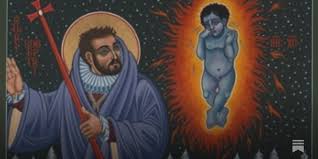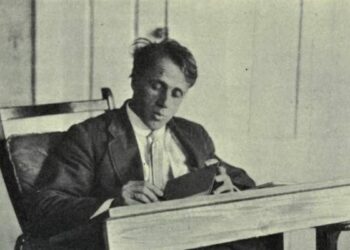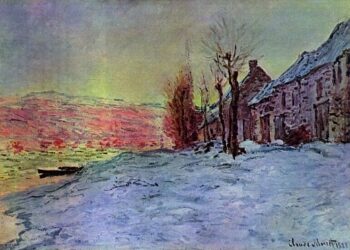Summary of The Burning Babe by Robert Southwell
Summary of The Burning Babe by Robert Southwell Robert Southwell, an English poet and Jesuit priest, wrote a Christmas poem titled “The Burning Babe” (1561-1595). The poem is typically taken as a reflection on the nature of Christ’s birth, examining themes of divine love, pain, and sacrifice.
A “burning babe” who symbolizes the Christ child and is blazing with heavenly love is described by the speaker, who is most likely Southwell himself. Throughout the poem, fire is used extensively to represent both the agony of Christ’s last crucifixion and God’s ardent love.
The poem opens with a detailed account of the newborn being set ablaze by a divine fire. This motif juxtaposes the extreme power and anguish that Christ will ultimately experience with the helpless, defenseless figure of a baby.
The speaker’s contemplation shifts from admiration for the child’s beauty to a more profound comprehension of the tragic destiny that awaits Christ. The burning picture is also used by Southwell to highlight the consuming force of God’s love, implying that it is both painful and purifying.
The Burning Babe by Robert Southwell Poem Notes
-
Theme of Divine Love: Southwell uses the burning flame as a metaphor for God’s love, which is both beautiful and painful. The fire symbolizes purification, holiness, and divine power. It is not merely destructive but transformative, pointing toward the eventual sacrifice of Christ.
-
Christ as the “Burning Babe”: The image of a baby aflame is unusual and striking. It suggests a burning desire to save humanity and serve as a reminder of the suffering that Jesus will experience in his life. Southwell contrasts the vulnerability of a baby with the strength and fire of divine love.
-
Imagery of Fire: Fire is symbolic in many religious texts, often representing the presence of God, purification, or judgment. In this poem, fire represents Christ’s overwhelming love and his mission to redeem humanity through suffering.
-
Contrast Between Innocence and Suffering: Summary of The Burning Babe by Robert Southwell The child is innocent and pure, yet the speaker hints at the future suffering Christ will endure. The poem blends the joy of Christ’s birth with the sorrow of his ultimate sacrifice.

In-Depth Analysis of The Burning Babe
1. Historical and Religious Context
Summary of The Burning Babe by Robert Southwell Author Background: Robert Southwell (1561–1595) was a Jesuit priest and martyr who wrote clandestine Catholic poetry during Protestant England’s persecution of Catholics.
Allegorical Purpose: The poem subtly critiques the era’s religious strife while affirming Christ’s eternal love.
2. Key Themes
Summary of The Burning Babe by Robert Southwell Divine Love and Sacrifice: The burning babe embodies Christ’s suffering for humanity’s sins.
Purification Through Fire: Fire represents both punishment (for sin) and grace (through redemption).
Humanity’s Redemption: The poem underscores the necessity of spiritual awakening.
3. Literary Devices
Metaphor: The infant Jesus = a “burning babe” engulfed in flames of love.
Paradox: “I, scorched in heart” contrasts physical pain with spiritual purpose.
Alliteration: “Fuel of love” emphasizes the poem’s emotional intensity.
Line-by-Line Explanation
First Stanza:
“As I in hoary winter’s night
The babe was born, the babe was born
At Bethlehem, the Christmas night,
The Burning Babe did come.”
- The speaker sets the scene during a cold winter’s night, symbolic of the darkness of the world into which Christ was born. The mention of Bethlehem connects the poem to the biblical Christmas story. The “Burning Babe” is introduced as a symbol of Christ’s birth.
Second Stanza:
“Into the world this babe did come,
In the form of man to save us all.
To light the way through every room,
The flame that’s burning bright.”
- This stanza emphasizes the purpose of Christ’s birth: to save humanity. The flame represents both Christ’s divine nature and the salvation he brings. It illuminates the world, bringing light into darkness.
Third Stanza:
“This is the true Christmas gift,
To fill the heart with love and light,
To bring mankind to end all strife,
And set the soul alight.”*
- Southwell emphasizes the transformative effect of Christ’s birth, calling it a “true gift” that brings light, love, and peace. The “end of strife” refers to the salvation that Christ offers, which can bring inner peace.
Final Stanza:
“Behold this burning child of light,
Whose fire will never fade nor die;
He lights the way through all the night,
A spark that shall not cease to fly.”*
- The final stanza reinforces the eternal nature of Christ’s light and love. The “burning child” is not just a temporary figure but one who will continue to shine forever, leading humanity through darkness.
Conclusion
Summary of The Burning Babe by Robert Southwell Robert Southwell provides a deep and nuanced analysis of the circumstances surrounding Christ’s birth in The Burning Babe. He illustrates the warmth and the anguish that are part of Christ’s mission with striking images of a baby on fire with heavenly love. Southwell highlights the strength and cleansing nature of God’s love by using fire as a metaphor.
The paradox of Christ’s birth—a happy occasion that portends great suffering—is something the poem challenges readers to think about. It also emphasizes how divine love, which still leads and purifies people, is transforming and eternal.
Written during a period of severe religious strife in England, Southwell’s work encourages readers to consider both Christ’s miraculous birth and impending sacrifice while speaking to the Christian hope in the redemptive power of Christ.
Summary of The Burning Babe by Robert Southwell By focusing on the greater theme of salvation and redemption rather than just the birth of a child, the poem promotes a broader comprehension of the Christmas tale.
(FAQ)
1. What is the main theme of “The Burning Babe”?
The main theme of The Burning Babe is the paradox of Christ’s birth — a moment of joy that foreshadows his future suffering. The poem also explores the overwhelming power of divine love, which is both beautiful and painful.
2. Why is the baby described as “burning”?
The “burning” image is symbolic of Christ’s divine love. It represents the intense, purifying nature of God’s love for humanity and the sacrifice Christ will make. Fire is used to emphasize both the power and the purity of that love.
3. What is the significance of the poem being about the Christmas story?
While Christmas is typically seen as a joyful occasion, Southwell’s poem contrasts this joy with the sorrow Christ will later experience. By focusing on the burning babe, Southwell connects Christ’s birth to his ultimate purpose: to suffer and redeem humanity.
4. How does Southwell use fire in the poem?
Southwell uses fire as a metaphor for Christ’s love and sacrifice. Fire represents both the warmth and beauty of divine love, as well as its ability to purify and transform. It also symbolizes the eternal nature of Christ’s influence on the world.
5. What is the overall tone of the poem?
The tone of the poem is a mixture of awe, reverence, and sorrow. While the imagery of the burning babe is striking and beautiful, it also hints at the pain and suffering that will come with Christ’s mission to save humanity.
6. Is The Burning Babe a traditional Christmas poem?
While it is set during the Christmas season, The Burning Babe departs from traditional Christmas themes by focusing not only on the joy of Christ’s birth but also on the suffering he will endure. It offers a more profound meditation on the deeper meaning of Christ’s coming.
Buy Ignou Assignment
📄 Solved Assignment PDFs – ₹50 each
📘 Exam Guides – ₹300 each
✍️ Handwritten Hardcopies – ₹350 each
📞 PHONE NUMBER – 81302028920 , 88822 85078
🛒 Buy PDFs Online: shop.senrig.in
Read More:

















